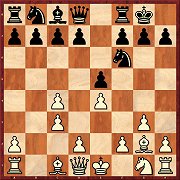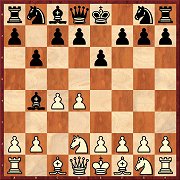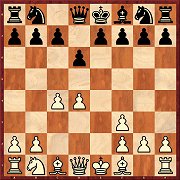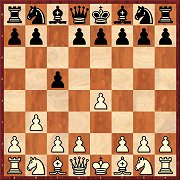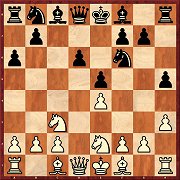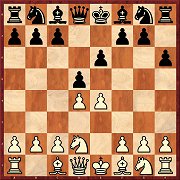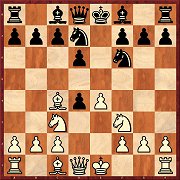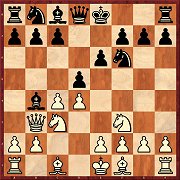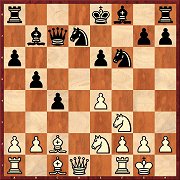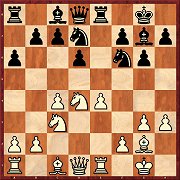Description
Opening Surveys
Stohl: English Mikenas A18
1.c4 Nf6 2.Nc3 e6 3.e4 d5 4.cxd5 exd5 5.e5 Ne4
|
|
|
According to Igor Stohl here is a trend here away from 4.e5 towards the intermediate exchange on d5. With precise play – starting with 5...Ne4 – Black can probably maintain equality, but it is not sufficient to act intuitively at the board, some knowledge is required. |
Ris: English A22
1.c4 e5 2.Nc3 Nf6 3.g3 Bb4 4.Bg2 0-0 5.e4 Bxc3 6.bxc3
|
|
|
Taking towards the centre on move 6 is probably preferable. Nevertheless White will not achieve an opening advantage. According to Robert Ris Black should start with 6...c6, then the most frequently played move is 7.Ne2 though 7.d4 and 7.Qb3 are probably more critical. |
Marin: Kangaroo Defence A40
1.d4 e6 2.c4 Bb4+ 3.Nd2 b6
|
|
|
Even after 3.Nd2 Mihail Marin follows an original path – first 3...b6, then generally ...f5 and ...Nf6. White can secure the bishop pair with 4.a3, but that does not necessarily lead to an advantage. |
Schipkov: Wade Defence A41
1.d4 d6 2.Nf3 Bg4 3.c4 Bxf3 4.exf3
|
|
|
Here there is an unusual structure on the board straight away and the usual plans cannot be employed. Boris Schipkov recommends in most lines a rapid h4 and g4; then White should get an advantage. |
Illingworth: Sicilian Defence B20
1.e4 c5 2.b3
|
|
|
Max Illingworth champions 2.b3 above all as a rapid chess repertoire. But it can be more than that as is shown by Tamaz Gelashvili, who in his 117 games in Mega has a score of 82%. But this does not mean that White gets an advantage with 2.b3. |
Berg: Sicilian Defence B22
1.e4 c5 2.c3 d5 3.exd5 Nf6
|
|
|
The unusual move presented by Emanuel Berg, 3...Nf6, sometimes leads to really sharp positions, above all when White wants to hang on to his extra pawn. But if he does not do so, then, according to the analyses of the Swedish grandmaster, Black should easily equalise. |
Krasenkow: Sicilian Defence B30
1.e4 c5 2.Nf3 Nc6 3.Bb5 e6
|
|
|
Michal Krasenkow presents his own repertoire (3...e6) against the Rossolimo Variation. In part 1 he deals with all the variations except 4.0-0; the focus is on 4.Bxc6 bxc6. The Polish grandmaster sees no problems for Black. |
Gormally: Sicilian Defence B47
1.e4 c5 2.Nf3 e6 3.d4 cxd4 4.Nxd4 Nc6 5.Nc3 Qc7 6.f4
|
|
|
The move 6.f4 is an interesting attempt to avoid the much analysed lines after 6.Be3. Daniel Gormally presents a series of model games, the study of which should improve your understanding of the different types of position. |
Postny: Sicilian Defence B90
1.e4 c5 2.Nf3 d6 3.d4 cxd4 4.Nxd4 Nf6 5.Nc3 a6 6.h3 e5 7.Nde2 h5
|
|
|
Evgeny Postny bases his article above all on recent games from elite tournaments. His analyses see equality for Black, but in many lines after 6.h3 there are still blank spots in the analysis and surprises are possible. |
Havasi: French Defence C03
1.e4 e6 2.d4 d5 3.Nd2 h6
|
|
|
According to Gergö Havasi Black would like to use this move of the rook pawn to transpose to variations in which ...h6 is useful and in which White has adopted an unfortunate setup. For example he may have played Ngf3, but Ne2 would suit better. |
Souleidis: Philidor Defence C41
1.e4 d6 2.d4 Nf6 3.Nc3 e5 4.Nf3 Nbd7 5.Bc4 exd4
|
|
|
Since after 5...Be7 White can immediately play 6.a4! (6.0-0 Nb6!?), Georgios Souleidis suggests 5...exd4. After 6.Nxd4 Nb6 would have achieved his aim, but 6.Qxd4 is better. Nevertheless the analyses show that Black’s plan is well suited to use as a surprise. |
Kuzmin: Queen's Gambit D38
1.d4 d5 2.c4 e6 3.Nf3 Nf6 4.Nf3 Bb4 5.Qb3
|
|
|
The best surprise weapons are those in which the opponent can only equalise with precise play. As Alexey Kuzmin shows in his article on 5.Qb3, Black really has to know what he is doing here, because he can then easily hold the balance. |
Schandorff: Semi-Slav D48
1.d4 d5 2.c4 c6 3.Nf3 Nf6 4.Nc3 e6 5.e3 Nbd7 6.Bd3 dxc4 7.Bxc4 b5 8.Bd3 Bb7
|
|
|
For some time there has been hope for White in the main variation: 14.Ne2!? is according to the statistics clearly more successful than the alternatives, though this is still based on a very small number of games. Lars Schandorff, howver, presents two strong replies for Black. |
Szabo: King's Indian E90
1.d4 Nf6 2.c4 g6 3.g3 Bg7 4.Bg2 0-0 5.Nc3 d6 6.Nf3 Nbd7 7.0-0 e5 8.e4 exd4 9.Nxd4 Re8 10.h3 a6 11.Re1
|
|
|
The Gallagher Variation (10...a6) is designed to be active rapidly (...c5 and ...b5). In the first part of his contribution Krisztian Szabo presents 11.Re1, but his analyses show that the rook move does not bring an advantage for the White side. |
Payment & Security
Your payment information is processed securely. We do not store credit card details nor have access to your credit card information.






